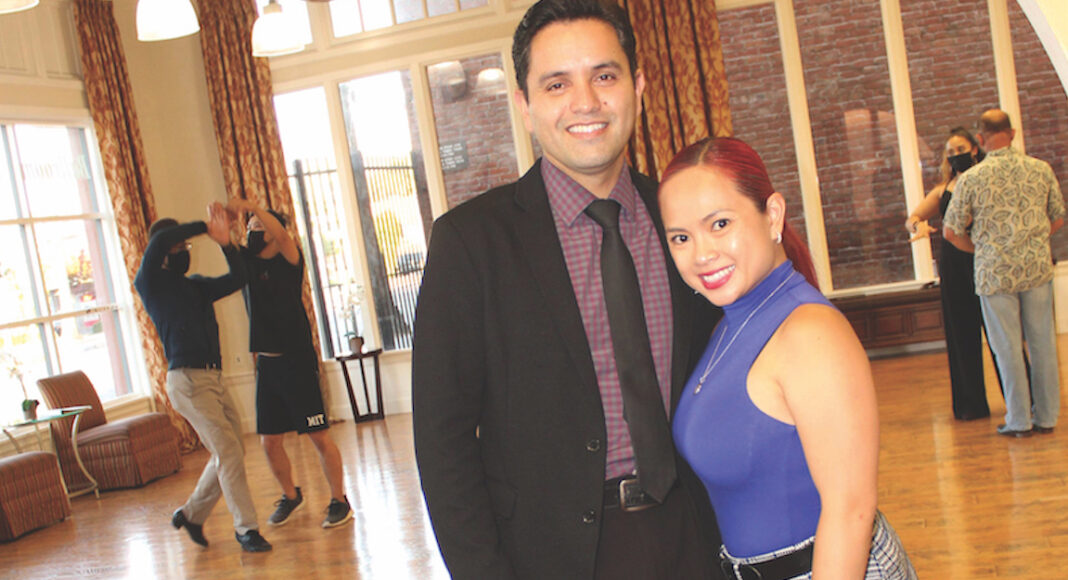Scotts Valley is signed up to a new future of dance, with a ballroom franchise set to open a location within weeks.
From salsa to cumbia, swing, Viennese waltz and tango, the owners of the new Arthur Murray location are thrilled to teach local residents new steps during the post-pandemic thaw.
“We’ve been cooped up in 2020,” said Richard Myers, who is opening the ballroom on Mt. Hermon Road with his wife Marianne. “For the people who haven’t done ‘dancing’ before, it’s attractive for them.”
The pair has run the Arthur Murray location in Fremont for the last eight years, while facing off against other couples in a variety of competitions across the country. But for Marianne, it isn’t about bringing home a trophy.
“I just love being able to spread the love of dancing,” she said. “For a lot of people, they want to look for something that’s a stress release; then they find something that’s beyond stress-relief.”
Richard agrees.
“You don’t have to be a world champion,” he said, leading his partner of 19 years.
“—to enjoy it,” Marianne said, as if completing a turn.
When Marianne was a child, dance was the only hobby that stuck. She learned ballet, jazz and hip-hop, and taught throughout her teenage years. But at 17 she figured it was probably time to get a “real job,” and settled on customer service or admin work as a possibility.
She applied for an administrative job at the Arthur Murray location in Hayward. But it turned out the owner needed a new dance teacher more than a desk jockey.
“I was actually trying to get out of dancing,” she said. “I somehow got sucked back in by fate.”
The only thing was, she didn’t know the ballroom styles taught by Arthur Murray.
“It’s like learning a new language,” she said. “It’s all movement, but a different skill set.”
While Marianne was picking up the vocabulary and grammar of physical flow, Richard—who she’d known since high school—was progressing up the corporate ladder.
Despite being promoted to lead teller at a bank, Richard says something wasn’t quite right.
“I gained so much weight,” he said. “All you do is stand there and eat fast food.”
In contrast, when they’d meet up for meals, he couldn’t help but notice how Marianne was positively glowing.
“She’s always upbeat, always excited—to be able to dance and to be able to help people,” he said. “I saw it as being free, in a way.”
It only took three months before Richard ditched his career in banking and threw himself into dance full bore. Within five years he was managing at the Arthur Murray Hayward location.
“It’s quite rewarding to teach,” he said. “Ballroom dancing is a community. Some people come in it for short term. Some people come in it for a lifestyle change.”
They were given the opportunity to expand into Fremont in 2014, and have been building up their team since then. Now they want to give their instructors similar opportunities, as they expand westward.
But finding the right home in the area wasn’t a cinch. They say they’ve been working toward this for three years.
“I’ve always known that Santa Cruz County is big in dancing,” Richard said. “Our hope is we can serve the community.”
They almost set up shop at another space in 2019, but that fell through at the last minute. When they found the Scotts Valley location, things clicked into place.
“It just felt like home,” Marianne said.
Added Richard: “It’s the first location where we both had the same vision.”
The big news follows a crushing year for the ballroom community as a result of the pandemic—after all, at its core, dancing is about bodies moving in close proximity.
At first, the Myers did what they could to accommodate emerging social-distancing guidelines. One instructor even used measuring sticks to ensure students were keeping their distance. But when the lockdowns went into place last year, in-person dancing totally stopped.
On the business end, the Myers went from planning a new location to scrambling to keep their first afloat.
“It was scary,” Marianne said, adding they were forced to start experimenting with new approaches. “We were on Zoom calls with all of our students.”
It was difficult to balance the realities of a virus bent on conquering the world with the human need for connection, she said, reflecting on the debate around what should be considered an “essential” business in California.
“A lot of students said they wish we were ‘essential,’ because, to them, we are,” Marianne said. “We may not be like doctors, but they felt like we help with the mental health part—that they couldn’t tap into.”
It made her think about their eldest student, a 95-year-old named Frank.
“He was the first person to say, ‘Call me when you’re open, I want to come in,’” she said.
Richard estimates they lost about 60-70% of their student body.
“A lot of students that took a break are starting to come back now,” he said, adding there are lots of fresh faces, too. “We’re seeing a lot of people say, ‘Hey I should try this before another pandemic happens.’”














Would this be good for Seniors? I’d be interested!
How much? and when?